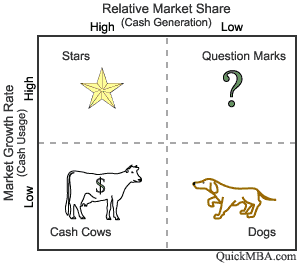
Resources are allocated to business units according to where they are situated on the grid as follows:
Cash Cow - a business unit that has a large market share in a mature, slow growing industry. Cash cows require little investment and generate cash that can be used to invest in other business units.
Star - a business unit that has a large market share in a fast growing industry. Stars may generate cash, but because the market is growing rapidly they require investment to maintain their lead. If successful, a star will become a cash cow when its industry matures.
Question Mark (or Problem Child) - a business unit that has a small market share in a high growth market. These business units require resources to grow market share, but whether they will succeed and become stars is unknown.
Dog - a business unit that has a small market share in a mature industry. A dog may not require substantial cash, but it ties up capital that could better be deployed elsewhere. Unless a dog has some other strategic purpose, it should be liquidated if there is little prospect for it to gain market share.
The BCG matrix provides a framework for allocating resources among different business units and allows one to compare many business units at a glance. However, the approach has received some negative criticism for the following reasons:
The link between market share and profitability is questionable since increasing market share can be very expensive.
The approach may overemphasize high growth, since it ignores the potential of declining markets.
The model considers market growth rate to be a given. In practice the firm may be able to grow the market.
These issues are addressed by the GE / McKinsey Matrix, which considers market growth rate to be only one of many factors that make an industry attractive, and which considers relative market share to be only one of many factors describing the competitive strength of the business unit.

No comments:
Post a Comment